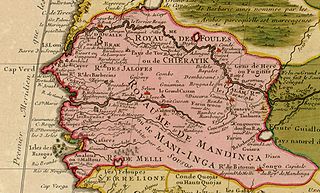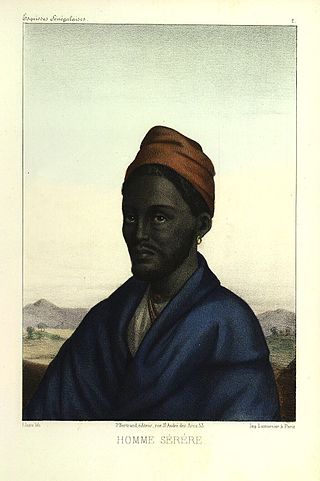Related Research Articles

The history of Senegal is commonly divided into a number of periods, encompassing the prehistoric era, the precolonial period, colonialism, and the contemporary era.

The West Atlantic languages of West Africa are a major subgroup of the Niger–Congo languages.

The Serer-Ndut or Ndut also spelt are an ethnic group in Senegal numbering 38600. They are part of the Serer people who collectively make up the third largest ethnic group in Senegal. The Serer-Ndut live mostly in western Senegal in the district of Mont-Roland, northwest of the city of Thiès.
The Cangin languages are spoken by 200,000 people in a small area east of Dakar, Senegal. They are the languages spoken by the Serer people who do not speak the Serer language (Serer-Sine). Because the people are ethnically Serer, the Cangin languages are commonly thought to be dialects of the Serer language. However, they are not closely related; Serer is closer to Fulani than it is to Cangin.
The Centre de linguistique appliquée de Dakar, abbreviated CLAD, is a language institute, which especially plays an important role in the orthographical standardization of the Wolof language.
Serer, often broken into differing regional dialects such as Serer-Sine and Serer saloum, is a language of the Senegambian branch of the Niger–Congo family spoken by 1.2 million people in Senegal and 30,000 in the Gambia as of 2009. It is the principal language of the Serer people, and was the language of the early modern kingdoms of Sine, Saloum, and Baol.

The Serer people are a West African ethnoreligious group. They are the third-largest ethnic group in Senegal, making up 15% of the Senegalese population. They also reside in northern Gambia and southern Mauritania.

There are various ethnic groups in Senegal. According to "CIA World Factbook: Senegal", the ethnic groups are Wolof (39%); Fula (27.5%)); Serer group ; Mandinka (4.9%); Jola (4.2%); Soninke (2.4%); other 5.4%, and other minor ethnic groups like the Bassari, Maures or (Naarkajors)). Many subgroups of those can be further distinguished, based on religion, location and language. According to one 2005 estimate, there are at least twenty distinguishable groups of largely varying size.
Safene (Saafen), Safi or Saafi-Saafi, is the principal Cangin language, spoken by 200,000 people in Senegal. Speakers are heavily concentrated in the area surrounding Dakar, particularly in the Thiès Region.

The Saltigue, are Serer high priests and priestesses who preside over the religious ceremonies and affairs of the Serer people, such as the Xooy ceremony, the biggest event in the Serer religious calendar. They usually come from ancient Serer paternal families, and the title is inherited by birthright. In Serer country, Saltigue are always diviners.

Women in Senegal have a traditional social status as shaped by local custom and religion. According to 2005 survey, the female genital mutilation prevalence rate stands at 28% of all women in Senegal aged between 15 and 49.
The Serer-Laalaa or Laalaa are part of the Serer ethnic group of Senegambia. They live in Laa, the Léhar Region, which comprises eighteen villages north of Thies and whose inhabitants are Serer-Laalaa. Although the people are ethnically Serer, their language Laalaa is not a dialect of the Serer-Sine language, but—like Saafi, Noon, Ndut and Palor, one of the Cangin languages.
The Serer-Noon also called Noon are an ethnic people who occupy western Senegal. They are part of the Serer people though they do not speak the Serer-Sine language natively.
Noon is a Cangin language of Senegal spoken in the Thiès region. There is an estimated population of 10,000- 50,000 speakers worldwide, rendering this language to be vulnerable. Ethnologue reports that it is 84% cognate with Lehar, essentially a divergent dialect, and 68% cognate with the other Cangin languages.
Palor is a language spoken in Senegal. The speakers of this language - the Palor people or Serer-Palor, are ethnically Serers but they do not speak the Serer-Sine language. Like the Lehar, Saafi, Noon and Ndut languages, their language is classified as one of the Cangin languages attached to the Niger–Congo family. Palor is closer to Ndut.
The Palors also known as Serer-Palor, among other names, are an ethnic group found in Senegal around the west central, west southwest of Thiès. They are a sub-group of the Serer ethnic group found in Senegal, the Gambia and Mauritania. Although ethnically Serers, they do not speak the Serer language but one of the Cangin languages. Their language is Palor.
Roog or Rog is the Supreme God and creator of the Serer religion of the Senegambia region.
Souleymane Faye is a Senegalese professor of linguistics at the Cheikh Anta Diop University (UCAD), current head of the Serer Division at the Centre de linguistique appliquée de Dakar, author of Serer and Cangin languages and a journalist. Himself Serer from the Faye family, he has authored and co-authored several books and papers in Serer, Wolof, French and English. As of 2015, Professor Faye is Head of Seereer and Cangin Languages at the Seereer Resource Centre.
The Lehar is an area in the western part of Senegal, located in north of Thies.
References
- ↑ Laalaa at Ethnologue (18th ed., 2015) (subscription required)